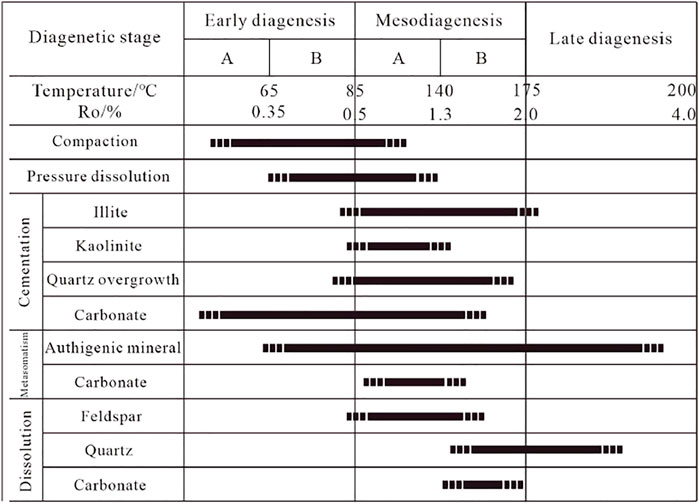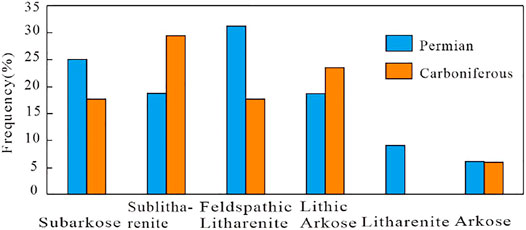- 1Shandong University of Science and Technology, Qingdao, China
- 2Laboratory for Marine Mineral Resources, Qingdao National Laboratory for Marine Science and Technology, Qingdao, China
- 3College of Resources, Shandong University of Science and Technology, Tai’an, China
- 4Petroleum Exploration and Exploitation Research Institute, Zhongyuan Oilfield Branch, SINOPEC, Puyang, China
- 5Shandong Zhongzhuo Huatu Limited Liability Company, Jinan, China
Based on the existing core and logging data, as well as previous research achievements, various experimental data were obtained by means of thin section, casting thin section, scanning electron microscopy, X-ray diffraction analyses, and cathodoluminescence. These data were used for the purposes of examining the features, diagenetic characteristics, and diagenetic evolution sequences of the Upper Paleozoic reservoirs of the Dongpu Depression, and analyzing the main controlling factors. The research results showed that the reservoir lithology was mainly subarkose, sublitharenite, feldspathic litharenite, and lithic arkose. The reservoir was generally characterized by ultra-low porosity and ultra-low permeability, with low porosity and low permeability in some areas. The pore types mainly include primary intergranular residual pores, dissolution pores, intercrystalline micropores, and microfractures. The pore throats are small and the throat channels are poorly sorted. The diagenetic processes mainly include compaction, pressure dissolution, cementation, metasomatism, and dissolution features of the research area. The diagenetic stages were determined to be mainly the middle diagenetic stages (Stage A and Stage B). The delta distributary channel and distributary bay of the Upper and Lower Shihezi Formation, along with the river channel sub-facies of the Shiqianfeng Formation, were considered to be the strata with good reservoir conditions. Moreover, the sand grains are dominated by medium-to-good sorting properties, sub-roundness and sub-angular, which provided a good spatial basis for the development of the primary pores. The calcite and kaolinite in the interstitial materials were corroded, which played a constructive role in the generation of the secondary pores. The results of the compaction, pressure dissolution, and cementation analyses indicate destructive diagenesis, which potentially reduced the porosity and permeability values. However, the dissolution, metasomatism, and chlorite lining cementation indicate improved diagenesis, which potentially increased the porosity and permeability values.
1 Introduction
With the continuous growth in the global demand for oil and gas and the continuous decline in the replacement rates of conventional oil and gas reserves, unconventional oil and gas products with major resource exploration potential have gradually become the focus of oil and gas research for the past 10 years (Davies et al., 2014; Zou et al., 2014; Clarkson and Qanbari, 2015; Wang et al., 2016; Song et al., 2017; Yang et al., 2017; Romero-Sarmiento et al., 2017; Lei et al., 2018; Wigwe et al., 2020; Katiyar et al., 2021; Bandara et al., 2021). The proportion of unconventional oil and gas in the world energy structure has been increasing. China’s dependence on foreign oil and gas has also been increasing year by year. Nevertheless, it has been found that unconventional oil and gas resources are rich in China, with major potential to become an important replacement field for oil and gas exploration and development (Kang and Zhou, 2016; Lv et al., 2019; Lv et al., 2020). The proven oil and gas geological reserves within the Dongpu Depression are mainly concentrated in the Paleogene. However, the exploration potential has become increasingly smaller, and the exploration processes continuously more difficult (Zeng et al., 2013; Xu et al., 2014; Wang et al., 2014; Luo et al., 2015; Liu et al., 2015; Li et al., 2015; Luo et al., 2016; Wang et al., 2016; Wang et al., 2018; Shao et al., 2018; Liu et al., 2018). Since industrial oil and gas flows were identified in the Upper Paleozoic of the Wengu 2 Well located in the central uplift belt, industrial coal-derived gas has been successfully obtained in the Upper Paleozoic strata of the Hugu 2 Well in the western slope belt, and stable productivity has been achieved. The discovery of these types of Paleozoic gas reservoirs indicate that the Upper Paleozoic strata have good exploration prospects, thereby potentially sensing for resource replacements (Li et al., 2015; Ni et al., 2015). However, the Dongpu Depression has had only two wells with the Upper Paleozoic as the target strata, the Wengu 3 Well and the Weigu 2 Well, since 1976. The remainder of the wells are located within the main exploration strata of the Lower Paleozoic or Paleogene, passing through and concurrently exploring the Upper Paleozoic. This has resulted in a high degree of drilling of the Upper Paleozoic with a low degree of understanding of the strata. Based on the analysis results of thin section, casting thin section, scanning electron microscopy, X-ray diffraction analyses, and cathodoluminescence, combined with previous research achievements, this study examined the characteristics of the Upper Paleozoic sandstone reservoir of the Dongpu Depression. The main factors controlling the development of the reservoir were defined, and important theoretical and practical significance were provided for guiding the future explorations and development of the Upper Paleozoic sandstone oil and gas resources in the Dongpu Depression.
2 Regional Geological Background
The Dongpu Depression is located within the southeastern section of the Linqing Depression on the southern edge of the Bohai Bay Basin. It is bounded in the east by the Lanliao Fault and the Luxi Uplift, overlapped in the west by the Neihuang Uplift, faces the Kaifeng Depression across the Lankao uplift in the south, and connects with the Shenxian Depression via the Maling Fault in the north. The depression has an NNE trending and is narrow in the north and wide in the south. The length of the Dongpu Depression is approximately 145 km, and its area has been determined to be approximately 5,300 km2 (Figure 1A). The Upper Paleozoic is composed of the Upper Carboniferous and Permian strata, which mainly consists of clastic rocks of paralic and continental facies. The strata can be divided into six units in ascending order: Benxi Formation of the Upper Carboniferous, Taiyuan Formation of the Lower Permian, Shanxi Formation and Lower Shihezi Formation of the Middle Permian, Upper Shihezi Formation and Shiqianfeng Formation of the Upper Permian. These strata were deposited in barrier coastal, carbonate platform, delta, lacustrine, and fluvial environments (Figure 1B). Following the deposition of the Paleozoic strata in the Dongpu Depression, the region mainly experienced three tectonic evolution stages: Paleozoic-Triassic craton basin evolution, Paleogene fault depression, and Neogene-Quaternary depression. The Dongpu Depression has been superimposed and transformed by such post tectonic movements as the Caledonian, Hercynian, Indosinian, Yanshan and Himalayan, and displays obvious “east-west zoning and north-south blocking” structural characteristics.
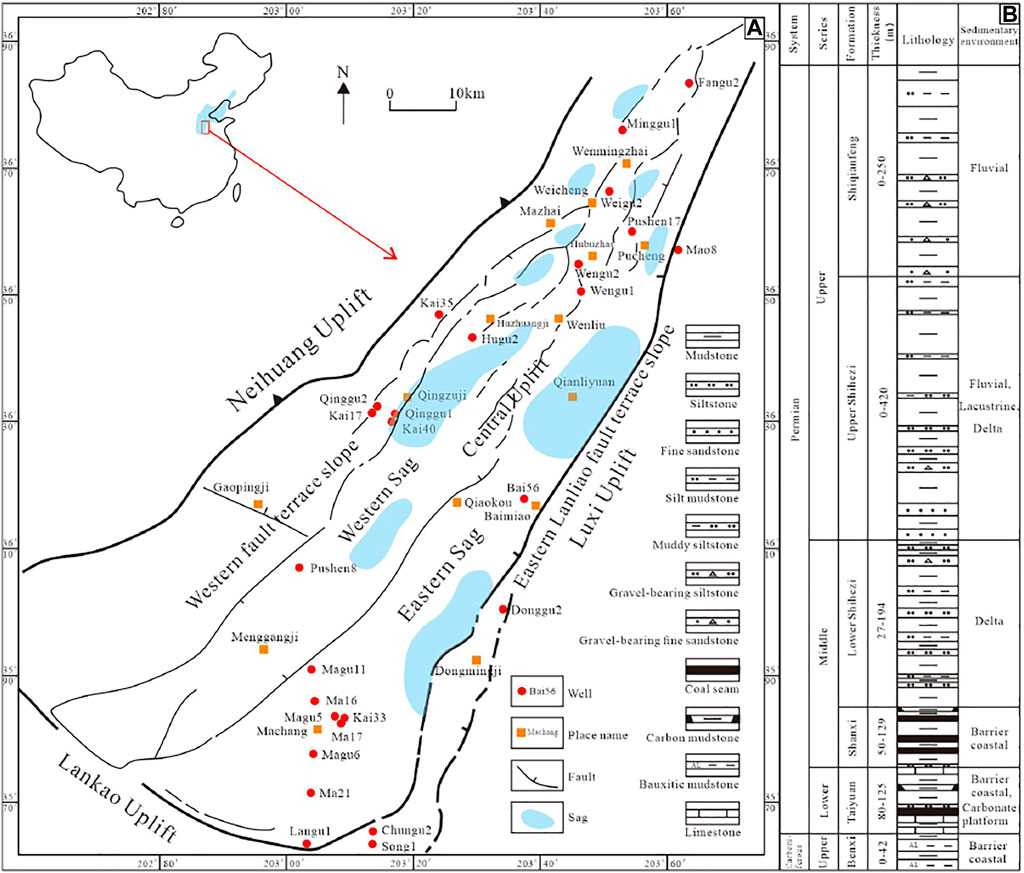
FIGURE 1. (A) Regional location and structural unit division of the Dongpu Depression; (B) Simplified stratigraphic column of the Dongpu Depression (Modified after the Zhongyuan Oilfield).
3 Basic Characteristics of the Reservoirs
3.1 Petrological Characteristics
This study found that the grain sizes are small in the study area. The rock types are generally silty to fine sandstone, with some fine to coarse sandstone and pebbly sandstone. The lithology was mainly subarkose, sublitharenite, feldspathic litharenite, and lithic arkose (Figure 2). Overall, quartz accounts for 15%–95%, feldspar for 1%–37.3%, and rock fragments for 4%–77.5%. The intergranular matrix is mainly argillaceous and tuffaceous material, and the cement is mainly carbonate, siliceous, argillaceous, and ferric. The content levels of quartz in the debris are high, and the composition maturity displays the characteristics of a medium-high type. The grains are mainly subangular, subangular to subrounded, and subrounded. In addition, the sorting is generally medium-to-good levels. The structural maturity is medium, and the cementation is mainly a porous cementation type (Table 1).
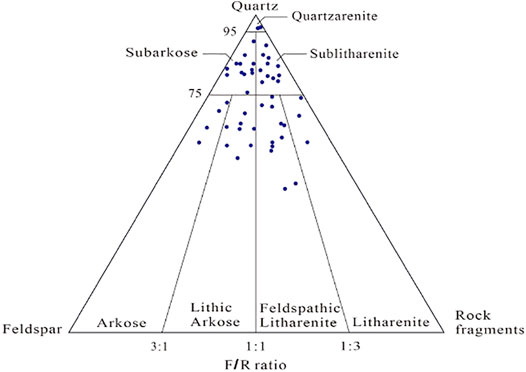
FIGURE 2. Ternary diagram of the Upper Paleozoic sandstone in the Dongpu Depression (after Folk, 1968).
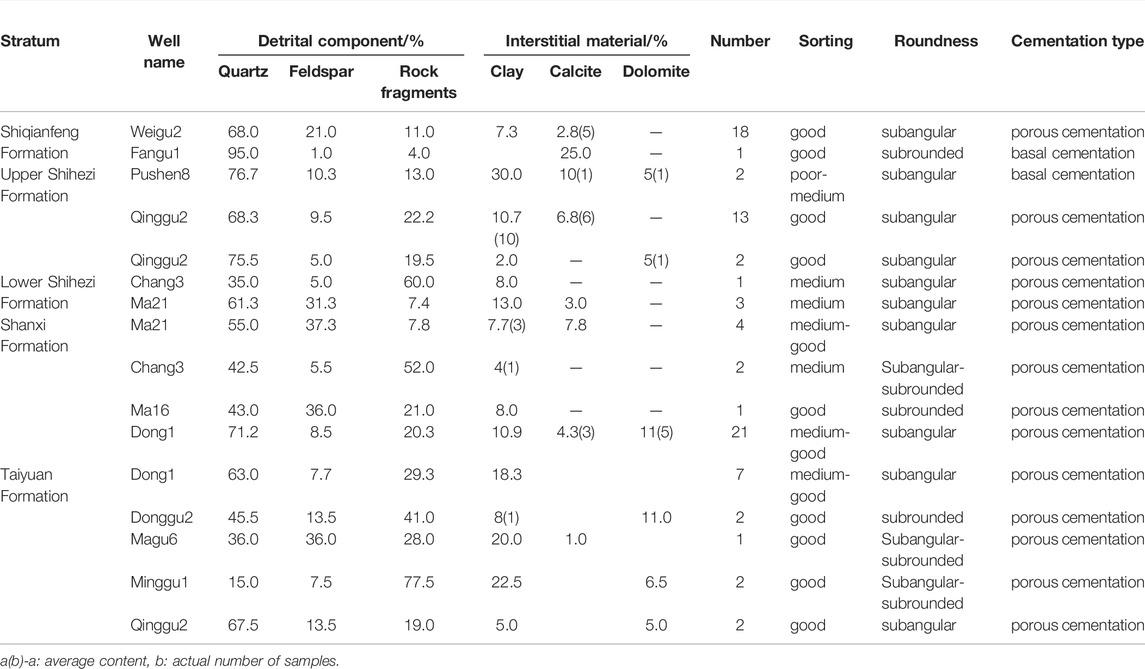
TABLE 1. Statistical table of rock composition and structural characteristics of Upper Paleozoic sandstone in Dongpu Depression (Yang, 2018).
3.2 Physical Characteristics
The porosity levels of the Upper Paleozoic reservoirs in the Dongpu Depression range between 0.2% and 22%, and mainly in the range of 5%–10%. The reservoir permeability levels are not high and generally fall within the range of 0.1–1.0 mD. Approximately, 70% of the permeability is less than 0.1 mD, and 90% of the permeability is less than 1 mD. The average porosity of each stratal unit is as follows: Benxi Formation, 4.5%; Taiyuan Formation, 5.4%; Shanxi Formation, 4.84%; Lower Shihezi Formation, 7.62%; Upper Shihezi Formation, 8.39%; and the Shiqianfeng Formation, 4.5% (Figure 3). The average permeability of each unit is as follows: Taiyuan Formation, 0.01 mD; Shanxi Formation, 0.05 mD; Lower Shihezi Formation, 0.04 mD; Upper Shihezi Formation, 0.05 mD; and the Shiqianfeng Formation, 0.198 mD. According to the classification standards of clastic rock reservoirs, the reservoir in the study area can be classified as generally having ultra-low porosity and ultra-low permeability, with low porosity and low permeability levels in some areas. A positive exponential correlation between the porosity and permeability values of the reservoirs is observed in each well location (Figure 4), with y = 0.0051e0.3672x, where y represents the permeability and x the porosity. It was found that when the porosity levels are greater than 5.5%, the permeability levels increase significantly with the increases in porosity. When the porosity is less than 5.5%, the connectivity between the pores is poor. In other words, there is little effective porosity. However, when the porosity levels are greater than 5.5%, the connectivity between the pores is obviously better, and the permeability is 0.05 mD.
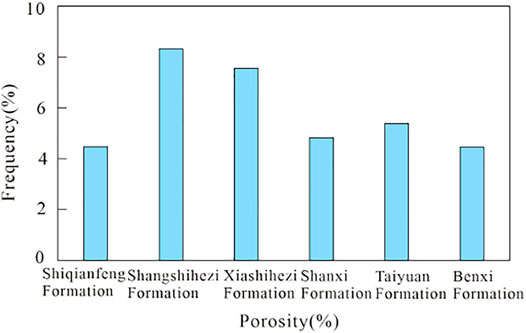
FIGURE 3. Histograms of the porosity levels of the Upper Paleozoic reservoirs within the Dongpu Depression.
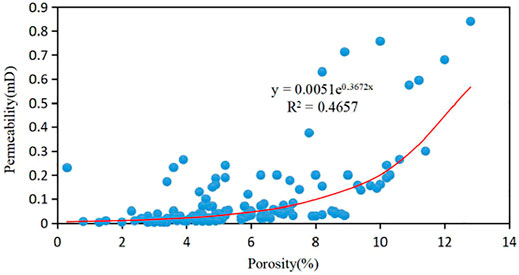
FIGURE 4. Relationships between the porosity and permeability levels within the Upper Paleozoic reservoirs of the Dongpu Depression (Yang, 2018).
3.3 Pore Types and Pore Structures
3.3.1 Pore Types
According to the data regarding the thin section, casting thin section, scanning electron microscopy, and cathodoluminescence, the pore types of the Upper Paleozoic reservoirs of the Dongpu Depression can be divided into primary intergranular residual pores, dissolution pores, intercrystalline micropores, and microfractures.
3.3.1.1 Primary intergranular residual pores
The primary intergranular residual pores are not well developed in the studied strata, accounting for 8% of the total pores. These types of pores were mainly identified in the shallow-buried quartzarenite and subarkose of the Shiqianfeng and Shihezi Formations (Figures 5A,B).
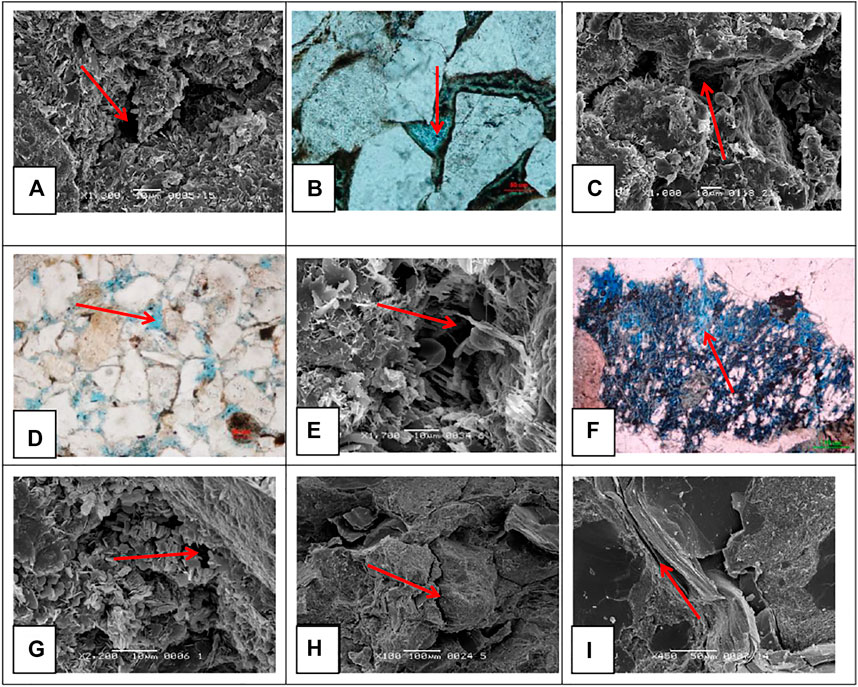
FIGURE 5. Pore types (red arrows) of the Upper Paleozoic reservoirs in the Dongpu Depression. (A) Primary intergranular residual pores of the Upper Shihezi Formation of the Qinggu 2 Well at a well depth of 3,796.70 m; (B) Primary intergranular residual pores of the Shiqianfeng Formation of the Weigu 2 Well at a well depth of 3,663.9 m; (C) Intergranular dissolution pores of the Shiqianfeng Formation of the Mao 8 Well at a well depth of 1,652 m; (D) Intergranular dissolved pores of the Lower Shihezi Formation of the Ma 21 Well at a well depth of 3,403.08 m; (E) Intragranular dissolved pores of the Lower Shihezi Formation of the Ma 21 Well at a well depth of 3,403.08 m; (F) Rock fragments Intragranular dissolution pores of the Lower Shihezi Formation of the Ma 71 Well at a well depth of 3,597 m; (G) intercrystalline micropores of the Taiyuan Formation of the Donggu 2 Well at a well depth of 2,352.16 m; (H) crushing microfractures of the Upper Shihezi Formation of the Ma 17 Well at a well depth of 3,466.10 m; (I) diagenetic contraction microfractures of the Shiqianfeng Formation of the Pushen 8 Well at a well depth of 5,333.40 m.
3.3.1.2 Dissolution pores
The dissolution pores are well developed in the strata of the study area, accounting for 65% of the total pores. There were two main types identified. The first are intergranular dissolved pores (Figures 5C,D), and the second are intragranular dissolved pores (Figure 5E,F). These types of pores are mainly developed in the subarkose and arkose of the Shihezi Formation. The intergranular dissolved pores formed by the dissolving of rock fragments, feldspar, and interstitial materials between the particles. The dissolved interstitial materials are mainly carbonate minerals, such as calcite. The intragranular dissolved pores formed by the dissolving of soluble clastic particle components, such as quartz, feldspar, and rock fragments particles.
3.3.1.3 intercrystalline micropores
The intercrystalline micropores are developed in the subarkose and sublitharenite of the Shihezi Formation in the study area, accounting for 23% of all the pores. The pores of such rocks are often filled with large kaolinite and calcite crystals which formed micropores less than 10 μm in diameter. The kaolinite intercrystalline micropore is the most common type (Figure 5G).
3.3.1.4 Microfractures
The microfractures include structural fractures, dissolution fractures, crushing fractures (Figure 5H), and diagenetic contraction fractures (Figure 5I). Those fractures account for approximately 4% of all the pores, and occur mainly in the Shanxi and Xiashihezi Formations. The lithology mainly includes lithic arkose. In addition, the microfractures widths vary greatly, from 20 to 0.3 μm. Although scarce, the microfractures improved the rock connectivity and permeability, which is of a major significance to the reservoir development.
3.3.2 Pore Structures
The average maximum pore throat radius of the Shiqianfeng Formation ranges between 0.16 and 1.41 μm (Table 2). The median radius is between 0.01 and 0.16 μm, the displacement pressure ranges from 2.15 to 4.55 MPa. In addition, the throat sorting coefficient is between 2.67 and 3.36. In the upper Shihezi Formation, the average maximum pore throat radius is 0.59–4.03 μm; median radius is 0.01–0.26 μm; displacement pressure ranges between 0.18 and 1.3 MPa; and the throat sorting coefficient is from 2.15 to 4.68. In the Lower Shihezi Formation, the average maximum pore throat radius is between 0.51 and 0.65 μm; median radius is 0.02–0.07 μm; displacement pressure ranges between 1.14 and 8.83 MPa; and the throat sorting coefficient averaged 2.62 to 3.57. The average maximum pore throat radius of the Shanxi Formation is 0.25 μm. The median radius is 0.04 μm, and the displacement pressure is 2.93 MPa. The throat sorting coefficient is 2.93. The average maximum pore throat radius of the Taiyuan Formation is 0.05 μm; median radius is 0.01 μm; displacement pressure is 17.45 MPa; and the throat sorting coefficient is 4.01. The Upper Paleozoic sandstone of the Dongpu Depression generally display the characteristics of high displacement pressure and median pressure. Small pore throats were observed, which indicates unfavorable pore structures with small pore throats and poor sorting characteristics. In the vertical direction, the pore throat radii of the Lower Shihezi Formation and Upper Shihezi Formation are relatively good, followed by the Shiqianfeng Formation and the Shanxi formations. Overall, the characteristics of the Taiyuan Formation were found to be the least favorable. In summary, the pore throat structures belong to the categories of Class II and Class III structures, of which the Class II structures account for 32% and the Class III structures account for 68%.
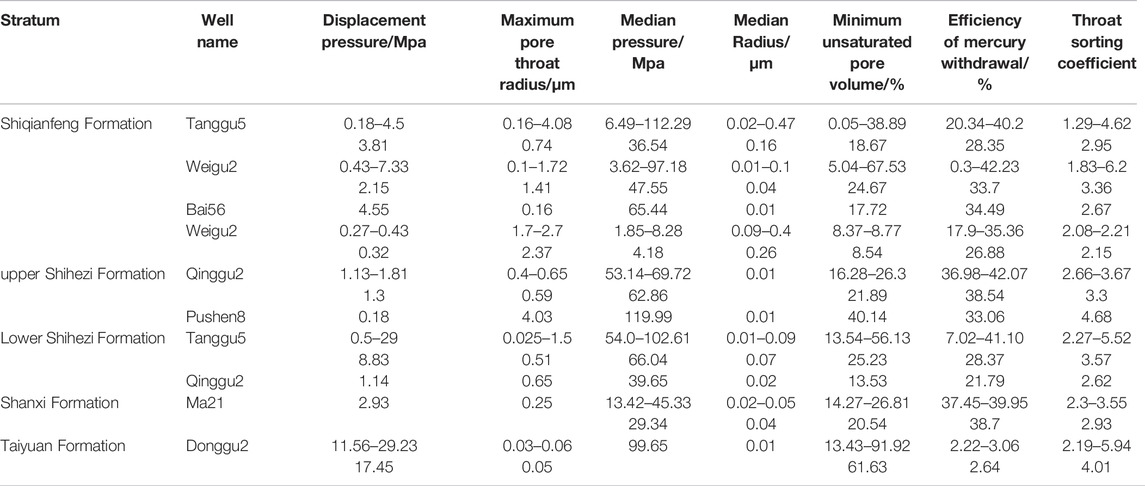
TABLE 2. Parameters of the throat structures within the sandstone reservoirs of the Dongpu Depression (According to the Zhongyuan Oilfield).
4 Characteristics of the Reservoir Diagenesis
4.1 Diagenesis Types
4.1.1 Compaction and Pressure Dissolution
The reservoir rocks in the study area are strongly compacted, and the clastic particles are mainly in point-line contacts (Figure 6A). With the increasing burial depths, dissolution deformations occur at the contact points of the feldspar and other particles, and the probability of concave-convex contacts (Figure 6B) and suture contacts increase. In addition, strong deformations of plastic particles (Figure 6C) and the fracturing of brittle particles, such as quartz and feldspar, are common (Figure 6A).
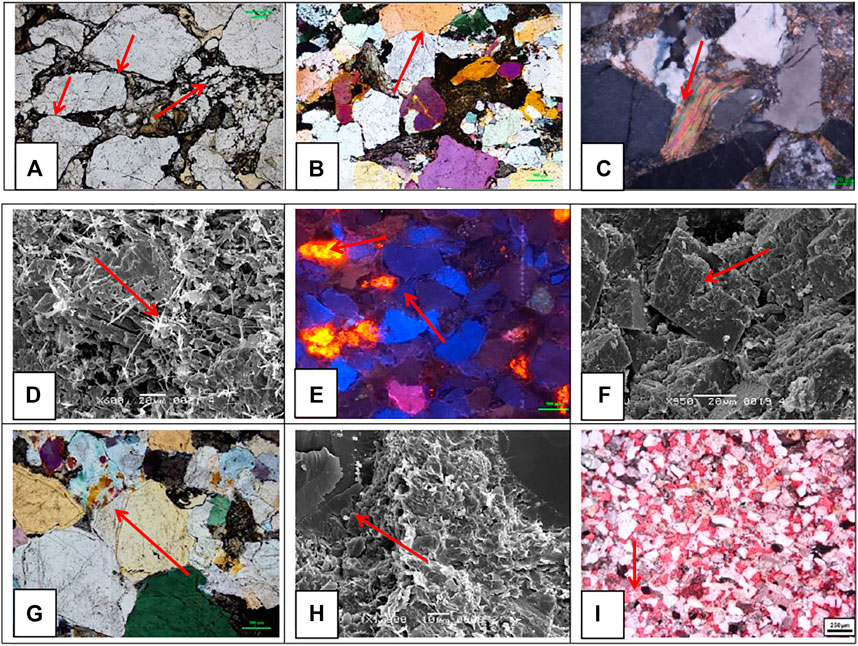
FIGURE 6. Cementation types (red arrows) of the Upper Paleozoic reservoirs in the Dongpu Depression. (A) Point-line contacts and quartz fractures of the Upper Shihezi Formation of the Kai 35–2 Well at a well depth of 2,704 m; (B) Concavo-convex contacts of the Lower Shihezi Formation of the Ma 71–1 Well at a well depth of 3,597 m; (C) Bending deformations of the mica of the Upper Shihezi Formation in the Wengu 2YX-16 Well at a well depth of 4,079 m; (D) Illite cementation of the Upper Shihezi Formation of the Ma17 Well at a well depth of 3,460.7 m; (E) Cementation of the calcite (orange) and kaolinite (dark blue) of the Upper Shihezi Formation of the Qinggu 2-1 Well at a well depth of 3,796 m; (F) Dolomite cementation of the Taiyuan Formation of the Donggu 2 Well at a well depth of 2,560 m; (G) Quartz secondary enlargement of the Upper Shihezi Formation of the Ma 17–1 Well at a well depth of 3,460 m; (H) Pyrite cementation of the Taiyuan Formation of the Magu 6 Well at a well depth of 3,095.80 m; (I) Calcite metasomatized of the quartz and rock fragments of the Shiqianfeng Formation of the Chang 4 Well at a well depth of 2,446 m.
4.1.2 Cementation
The reservoirs in the study area are strongly influenced by cementation. Mainly argillaceous cementation was observed, followed by carbonate cementation, with small amounts of siliceous and pyrite. The cementation modes are mainly pore type or contact type. The argillaceous cement includes illite (Figure 6D), kaolinite (Figure 6E), chlorite, and illite/smectite mixed layers minerals. However, it is difficult to distinguish them from the argillaceous matrix using microscopic methods. The carbonate cement is mainly calcite (Figure 6E), with rare dolomite (Figure 6F). The siliceous cementation is characterized by quartz secondary enlargement (Figure 6G), which has the distribution characteristics of small amounts, but high frequency. In regard to the pyrite cementation, the pyrite fill between particles in patches or dispersions (Figure 6H), also with the distribution characteristics of small amounts, but high frequency.
4.1.3 Metasomatism
The metasomatism is not obvious in the reservoir sandstone of the study area, and the majority of the quartz and feldspar are metasomatized by clay and carbonate minerals (Figure 6I).
4.1.4 Dissolution
Dissolution is common within the study area, and also distributed in the strata of each formation of the Upper Paleozoic (Figures 5C–G).
4.2 Division of the Diagenetic Stages
In the present investigation, through the analysis of the casting thin section, scanning electron microscopy, clay mineral X-ray diffraction, and cathodoluminescence, and in accordance with the division standards of the diagenetic stages of clastic rock, the diagenetic stages of the Upper Paleozoic in the Dongpu Depression are mainly the middle diagenetic stages A to B. The main basis for that conclusion includes the following: 1) The proportion of smectite in the illite/smectite mixed layer in the sandstone ranges between 10% and 45%; 2) The authigenic kaolinite minerals are flaky (Figure 5A,G), and the illite is flaky and hairy (Figures 5C, 6D). The chlorite is foliated (Figure 5G); 3) The contact modes between the particles are mainly point-line contacts (Figure 6A). In areas with large burial depths and strong compaction, concave-convex contacts or suture contacts also occur (Figure 6B). Furthermore, the increased calcite cement and secondary quartz are widely distributed; 4) The vitrinite reflectance in the Upper Paleozoic ranges between 0.51% and 2.19%; 5) The maximum pyrolysis peak temperatures (Tmax) in the reservoir are mainly between 400°C and 500°C (Figure 7).
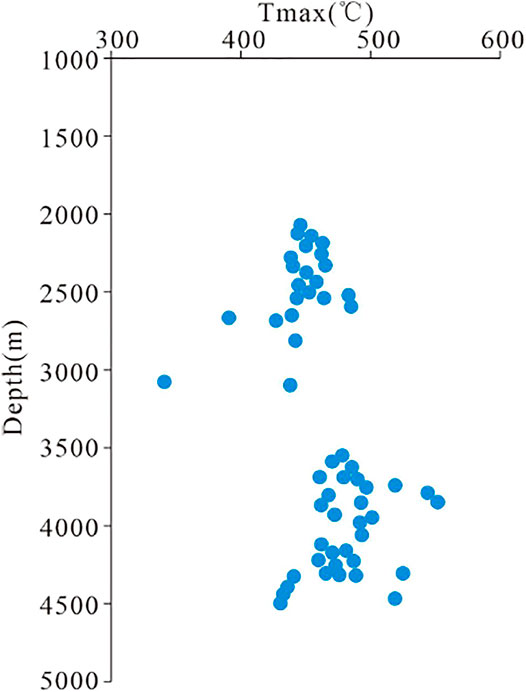
FIGURE 7. Relationships between Tmax and the depth of the Upper Paleozoic reservoirs in the Dongpu Depression (Yang, 2018).
4.3 Diagenetic Evolution Sequence
A diagenetic evolution model of the Upper Paleozoic in the study area was constructed by studying the relationships between the diagenesis (Figure 8). It was revealed that the strata in the study area first experienced compaction. The pressure of the overlying strata deformed the plastic particles in the rock, forming close linear contacts and concave-convex contacts, which greatly reduced the primary pores. Pressure dissolution occurred and the contact points between the rock particles became closer forming pressure dissolution joints. Subsequently, the mica and feldspar were altered and transformed into kaolinite. The authigenic minerals, such as siderite and calcite, were cemented and metasomatized, in which the siderites mainly metasomatized the original heterobase. Then, the secondary quartz (feldspar) increased, and calcite cementation and metasomatism occurred in the remaining pore spaces. This resulted in the disappearance of the majority of the residual intergranular pores. The subsequent dissolution dissolved the cement and feldspar fragments particles, which improved the porosity and permeability of the reservoirs, thereby having positive impacts on the rock reservoirs in the study area.
5 Main Controlling Factors of the Reservoir Development
5.1 Control of the Reservoir Development by the Sedimentary Facies Belt
Due to various depositional environments, the reservoir sand bodies in the study area had various influencing effects on the physical properties of the reservoirs. Tidal flat sand bodies are dominant in the Benxi Formation, which display small thicknesses of single layers, poor continuity of the transverse distribution, generally fine and compact lithology, and overall poor reservoir conditions. The Taiyuan Formation is mainly composed of tidal flat and lagoonal facies. In addition, barrier island sand bodies with certain reservoir conditions were developed locally. However, the lateral and longitudinal distributions are very limited, and the reservoir conditions of the formation are poor. The Shanxi Formation is tidal flat-delta facies which is mainly composed of silt and sand deposits. The reservoir conditions are poor, but better than those of the Benxi and Taiyuan formations. The Upper and Lower Shihezi formations are both delta distributary channels and distributary bay sedimentary successions. Therefore, the differences in porosity values are small, by only 1%–2%; the two formations contain strata with the best reservoir conditions with the potential for effective reservoirs to have developed (Li et al., 2017). During the deposition of the Shiqianfeng Formation, the area transitioned into fluvial sedimentary facies with slightly poor reservoir conditions.
5.2 Control of the Rock Characteristics on the Physical Properties of the Reservoirs
Generally speaking, the higher the composition maturity is, the better the reservoir is. In the clastic components of the Dongpu Depression, the content levels of feldspar are high (Figure 9). Since feldspar is soluble, high feldspar content levels may become a favorable condition for the development of secondary pores. The general medium-to-good sorting properties, along with the sandstone roundness dominated by subrounded and subangular in the Dongpu Depression, provide a good spatial basis for the development of pores. The cementation modes are mainly pore types, followed by contact types, and there are very few basement types observed. The average content of the interstitial materials is high. The calcite and kaolinite in the interstitial materials easily dissolve, which play a constructive role in the generation of secondary pores and provide the materials and spatial basis for the development of secondary pores. Among those, the basement cementation also appears in the Shiqianfeng and the Upper Shihezi formations, which is conducive to the development of secondary pores.
5.3 Control of the Diagenesis on the Physical Properties of the Reservoirs
5.3.1 Destructive diagenesis
5.3.1.1 Compaction and pressure dissolution
Strong compaction and pressure dissolution occurred in the Upper Paleozoic of the Dongpu Depression, which greatly reduced the porosity and permeability. Generally speaking, the porosity and permeability of the sandstone reservoirs in the Dongpu Depression tend to decrease with the increases in depth. The physical properties of the sandstone reservoirs are good at depths of less than 2,500 m, and poor at depths more than 2,500 m (Figures 10, 11). The lateral variations of the porosity and permeability at 2,500 m varies with the lateral variation of stratum sedimentary facies.
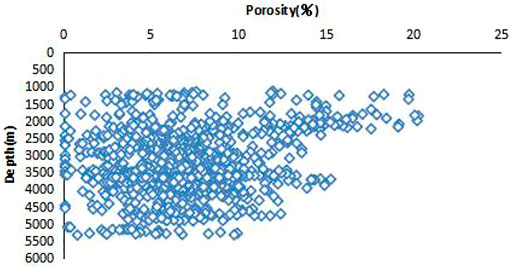
FIGURE 10. Relationships between the porosity levels and the depths of the Upper Paleozoic reservoirs in the Dongpu Depression (Zhang, 2018).
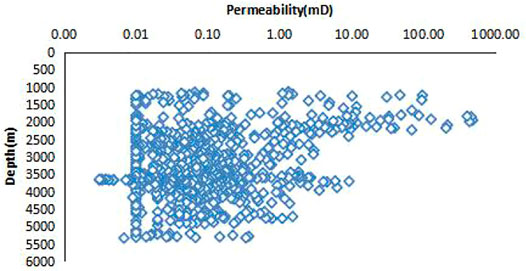
FIGURE 11. Relationships between the permeability levels and the depths of the Upper Paleozoic reservoirs in the Dongpu Depression (Zhang, 2018).
5.3.1.2 Cementation
According to the relationships between the reservoirs’ sandstone porosity levels and the cement content in the study area (Figures 12, 13), a negative correlation occurs between them. The increases in cement content further occupy the pore spaces and reduce the porosity levels. The carbonate cement, argillaceous cement, and quartz cement occupy the pore spaces, and narrow or block the throat channels, thereby reducing the porosity and permeability levels. In this study, carbonate cement refers to the late cementation, which filled the pores without dissolution.
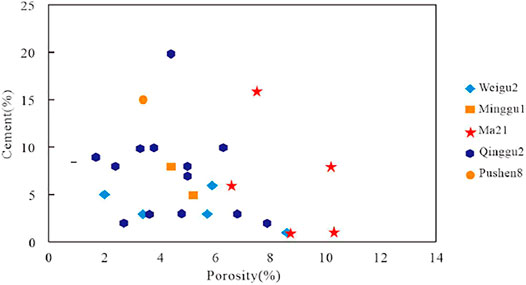
FIGURE 12. Relationships between porosity levels and cement content levels of the Upper Paleozoic reservoirs in the Dongpu Depression.
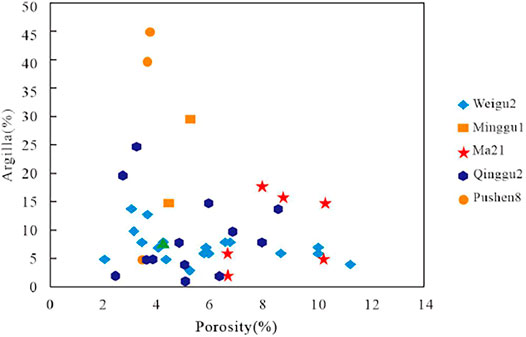
FIGURE 13. Relationships between the porosity levels and argilla content levels of the Upper Paleozoic reservoirs in the Dongpu Depression.
5.3.2 Constructive diagenesis
5.3.2.1 Dissolution
The Upper Paleozoic reservoirs of the Dongpu Depression are basically in the middle diagenetic Stage A. The minerals formed during that diagenetic stage mainly include quartz, dolomite, kaolinite, illite, and chlorite, among which the content of kaolinite is high. The vitrinite reflectance ranges between 0.5% and 1.3%. This is the main period of organic acid production during the process of organic matter maturation, and it was an acidic diagenetic environment. A large number of organic acids started to dissolve the feldspar, early cemented carbonate, tuffaceous, and other unstable components, forming a large number of secondary dissolution pores. This improved the porosity of the dissolution area and increased its permeability. However, the dissolution materials tend to migrate to nearby areas and settle there. Therefore, for the entire Upper Paleozoic strata, the porosity was not increased as a result.
5.3.2.2 Metasomatism
During the metasomatism in the study area, the quartz and feldspar were metasomatized by clay and carbonate minerals. The metasomatic products provided the material basis for the later dissolution. Then, following the dissolution of the clay and carbonate minerals, a large number of pores were left, which promoted the transformation of the reservoirs’ physical properties via dissolution.
5.3.2.3 Chlorite lining cementation
Chlorite lining plays an important role in inhibiting the increases in secondary quartz and feldspar, along with slowing the progress of compaction and pressure dissolution (Dou et al., 2017; Wang et al., 2017). The abnormally high porosity caused by chlorite lining only appeared in the quartz rich sandstone. This was due to the weak cementation of the quartz in the quartz poor sandstone and the easy deformation of the plastic particles, which had no obvious effects on the chlorite lining. In addition, authigenic chlorite, as a mineral crystallized from solution, requires a great deal of fluid activities for its formation. The more developed the pores were, the more conducive the conditions for fluid flow would be. Therefore, the high content levels of authigenic chlorite were considered to indicate high reservoir porosity and good pore connectivity.
6 Conclusion
1) The sandstone types in the study area are mainly subarkose, sublitharenite, feldspathic litharenite, and lithic arkose. The composition maturity belongs to a medium-high type. The roundness characteristics are mainly divided into three levels: subangular, subangular to subrounded, and subrounded. The sorting properties are medium-to-good and the structural maturity is medium. The cementation type is mainly pore type. On the whole, the reservoir is classified in this study as having ultra-low porosity and ultra-low permeability, with low porosity and low permeability levels in some areas, and medium porosity and medium permeability levels in a few sections of the Shangshihezi Formation. There is a positive exponential correlation between the porosity and permeability. The types of reservoir spaces mainly include primary intergranular residual pores, dissolution pores, intercrystalline micropores, and microfractures. The pore throat structures of the reservoirs are as follows: Class II accounted for 32%, and Class III for 68%.
2) The diagenesis is mainly compaction, cementation, and dissolution. The diagenetic stages are mainly within the middle diagenetic stages (Stage A and Stage B). The evolution sequence is mainly the compaction-pressure dissolution-alteration of the mica and feldspar, along with the transformation results of the kaolinite-the cementation and metasomatism of authigenic minerals, such as siderite, calcite -increases of the secondary quartz (feldspar)and the cementation and metasomatism of the calcite-dissolution.
3) This study determine that the sedimentary facies, reservoir rock characteristics, and diagenesis are the three main factors controlling the physical properties of the Upper Paleozoic reservoirs in the Dongpu Depression. The delta distributary channel and interdistributary bay of the Upper and Lower Shihezi Formations, as well as the river channel subfacies of the Shiqianfeng Formation, are strata with good reservoir conditions. The content levels of feldspar in the clastic components of the Dongpu Depression is high. There are higher content levels of calcite and kaolinite in the interstitial, and the sorting of the sandstone is generally at a medium level. The rounding types are generally subangular and subrounded. these provide material and spatial basis for the development of secondary pores. The compaction and pressure solution processes are the diagenesis which destroyed the porosity and permeability to the greatest extent. The late carbonate cement, argillaceous cement, and quartz cement occupy the pore spaces, narrow or block the throat channels, and reduce the porosity and permeability levels in the reservoirs. Large amounts of organic acids dissolved the unstable components (such as the feldspar), early cemented carbonates, and tuffaceous, which formed a large number of secondary dissolution pores. As a result, the porosity and permeability levels of the dissolution area were improved.
Data Availability Statement
The raw data supporting the conclusions of this article will be made available by the authors, without undue reservation.
Author Contributions
All the authors have actively participated in the preparation of this manuscript. JY and XZ designed the research. XZ wrote the manuscript. These two researchers also reviewed and proofread the manuscript. JP collated and processed data. ZY and HZ drew the drawings.
Conflict of Interest
JP was employed by Petroleum Exploration and Exploitation Research Institute, Zhongyuan Oilfield Branch, SINOPEC. HZ was employed by Shandong Zhongzhuo Huatu Limited Liability Company.
The remaining authors declare that the research was conducted in the absence of any commercial or financial relationships that could be construed as a potential conflict of interest.
The reviewer DL declared a shared affiliation with the authors to the handling editor at time of review.
Publisher’s Note
All claims expressed in this article are solely those of the authors and do not necessarily represent those of their affiliated organizations, or those of the publisher, the editors and the reviewers. Any product that may be evaluated in this article, or claim that may be made by its manufacturer, is not guaranteed or endorsed by the publisher.
References
Bandara, K. M. A. S., Ranjith, P. G., Rathnaweera, T. D., Wanniarachchi, W. A. M., and Yang, S. Q. (2021). Crushing and Embedment of Proppant Packs under Cyclic Loading: An Insight to Enhanced Unconventional Oil/gas Recovery. Geosci. Front. 12 (6), 100970–101018. doi:10.1016/j.gsf.2020.02.017
Clarkson, C. R., and Qanbari, F. (2015). A Semianalytical Forecasting Method for Unconventional Gas and Light Oil Wells: A Hybrid Approach for Addressing the Limitations of Existing Empirical and Analytical Methods. SPE Reservoir Eval. Eng. 18 (1), 94–110. doi:10.2118/170767-PA
Davies, R. J., Almond, S., Ward, R. S., Jackson, R. B., Adams, C., Worrall, F., et al. (2014). Oil and Gas wells and Their Integrity: Implications for Shale and Unconventional Resource Exploitation. Mar. Pet. Geology. 56, 239–254. doi:10.1016/j.marpetgeo.2014.03.001
Dou, W. C., Liu, L. F., Wu, K. J., Xu, Z. J., and Feng, X. (2017). Diagenesis of Tight Oil Sand Reservoirs: Upper Triassic Tight Sandstones of Yanchang Formation in Ordos Basin, China. Geol. J. 53, 707–724. doi:10.1002/gj.2922
Gaupp, R., Matter, A., Platt, J., Ramseyer, K., and Walzebuck, J. (1993). Diagenesis and Fluid Evolution of Deeply Buried Permian (Rotliegende) Gas Reservoirs, Northwest Germany. AAPG Bulletin 77 (7), 1111–1128. doi:10.1306/bdff8e0c-1718-11d7-8645000102c1865d
Kang, Y. Z., and Zhou, L. (2016). The Strategic Thinking of Unconventional Petroleum and Gas in China. Earth Sci. Front. 23 (2), 1–7. doi:10.13745/j.esf.2016.02.001
Katiyar, A., Patil, P. D., Rohilla, N., Crosley, M., Miller, T., Rozowski, P., et al. (2021). Unconventional Reservoir Hydrocarbon-Gas Foam Enhanced-Oil-Recovery Pilot: Design, Implementation, and Performance Analysis. SPE Reservoir Eval. Eng. 24 (1), 194–204. doi:10.2118/201199-PA
Lei, Q., Yang, L. F., Duan, Y. Y., Weng, D. W., Wang, X., Guan, B. S., et al. (2018). The "Fracture-Controlled Reserves" Based Stimulation Technology for Unconventional Oil and Gas Reservoirs. Pet. Exploration Dev. 45 (4), 770–778. doi:10.1016/S1876-3804(18)30080-6
Li, J. D., Xu, S. T., Yang, Y. E., Ke, M. W., and Zhao, Q. (2015). Forming Condition Analysis of Hugu 2 Gas Reservoir in Dongpu Depression. Fault-block Oil & Gas Field 22 (4), 450–453. doi:10.6056/dkyqt201504009
Li, X., Zhang, J. L., Xie, J., Li, C. L., Dai, Y. J., Li, W. L., et al. (2014). Sedimentary and Sequence-Stratigraphic Characteristics of the Lower Second Submember, Shahejie Formation, M1 Block, Wenmingzhai Oilfield, Dongpu Depression, China. Arab J. Geosci. 8 (8), 5397–5406. doi:10.1007/s12517-014-1579-4
Li, Z., Wu, S. H., Xia, D. L., Zhang, X. F., and Huang, M. (2017). Diagenetic Alterations and Reservoir Heterogeneity within the Depositional Facies: A Case Study from Distributary-Channel belt sandstone of Upper Triassic Yanchang Formation Reservoirs (Ordos Basin, China). Mar. Pet. Geology. 86, 950–971. doi:10.1016/j.marpetgeo.2017.07.002
Liu, L. L., Zhang, J. L., Wang, J. K., Li, C. L., Yu, J. T., Zhang, G. X., et al. (2015). Geostatistical Modeling for fine Reservoir Description of Wei2 Block of Weicheng Oilfield, Dongpu Depression, China. Arab J. Geosci. 8, 9101–9115. doi:10.1007/s12517-015-1924-2
Liu, W. B., Zhang, S. Q., Li, S. Z., Zhou, X. G., Wang, D. D., Zhang, W. H., et al. (2018). Development Characteristics and Geological Significance of Microfractures in the Es3 Reservoirs of Dongpu Depression. Geolog Bullet China 37, 496–502. [in Chinese with English Abstract]
Luo, Y., Liu, H. P., Zhao, Y. C., Wang, Y. Z., Zhang, J. G., and Lü, X. H. (2016). Reevaluation of the Origin of Overpressure in the Inter-salt Shale-Oil Reservoir in Liutun Sag, Dongpu Depression, China. J. Pet. Sci. Eng. 146, 1092–1100. doi:10.1016/j.petrol.2016.08.011
Luo, Y., Zhao, Y. C., Chen, H. H., and Su, H. (2015). Fracture Characteristics under the Coupling Effect of Tectonic Stress and Fluid Pressure: A Case Study of the Fractured Shale Oil Reservoir in Liutun Subsag, Dongpu Sag, Bohai Bay Basin, Eastern China. Pet. Exploration Dev. 42 (2), 196–205. doi:10.1016/s1876-3804(15)30006-9
Lv, D. W., Li, Z. X., Wang, D. D., Li, Y., Liu, H. Y., Liu, Y., et al. (2019). Sedimentary Model of Coal and Shale in the Paleogene Lijiaya Formation of the Huangxian Basin: Insight from Petrological and Geochemical Characteristics of Coal and Shale. Energy Fuels 33, 10442–10456. doi:10.1021/acs.energyfuels.9b01299
Lv, D. W., Song, Y., Shi, L. Q., Wang, Z. L., Cong, P. Z., and van Loon, A. J. (2020). The Complex Transgression and Regression History of the Northern Margin of the Palaeogene Tarim Sea (NW China), and Implications for Potential Hydrocarbon Occurrences. Mar. Pet. Geology. 112, 104041–104117. doi:10.1016/j.marpetgeo.2019.104041
Ni, C. H., Bao, J. P., Zhou, X. J., Xu, S. T., Xu, L. F., Xu, T. W., et al. (2015). Geochemical Characteristics and Types of Natural Gas from Well Hugu 2 in the Dongpu Sag of Bohai Bay Basin. Pet. Geology. & Exp. 37, 764–769. doi:10.11781/sysydz201506764
Romero-Sarmiento, M. F., Ramiro-Ramirez, S., Berthe, G., Fleury, M., and Littke, R. (2017). Geochemical and Petrophysical Source Rock Characterization of the Vaca Muerta Formation, Argentina: Implications for Unconventional Petroleum Resource Estimations. Int. J. Coal Geology. 184, 27–41. doi:10.1016/j.coal.2017.11.004
Shao, X. H., Pang, X. Q., Li, H., Hu, T., Xu, T. W., Xu, Y., et al. (2018). Pore Network Characteristics of Lacustrine Shales in the Dongpu Depression, Bohai Bay Basin, China, with Implications for Oil Retention. Mar. Pet. Geology. 96, 457–473. doi:10.1016/j.marpetgeo.2018.06.015
Song, Y., Li, Z., Jiang, Z. X., Luo, Q., Liu, D. D., and Gao, Z. Y. (2017). Progress and Development Trend of Unconventional Oil and Gas Geological Research. Pet. Exploration Dev. 44 (4), 675–685. doi:10.1016/S1876-3804(17)30077-0
Wang, G. W., Chang, X. C., Yin, W., Li, Y., and Song, T. T. (2017). Impact of Diagenesis on Reservoir Quality and Heterogeneity of the Upper Triassic Chang 8 Tight Oil Sandstones in the Zhenjing Area, Ordos Basin, China. Mar. Pet. Geology. 83, 84–96. doi:10.1016/j.marpetgeo.2017.03.008
Wang, H. J., Ma, F., Tong, X. G., Liu, Z. D., Zhang, X. S., Wu, Z. Z., et al. (2016). Assessment of Global Unconventional Oil and Gas Resources. Pet. Exploration Dev. 43 (6), 925–940. doi:10.1016/S1876-3804(16)30111-2
Wang, K., Pang, X. Q., Zhang, H. G., Zhao, Z. F., Su, S. C., and Hui, S. S. (2018). Characteristics and Genetic Types of Natural Gas in the Northern Dongpu Depression, Bohai Bay Basin, China. J. Pet. Sci. Eng. 170, 453–466. doi:10.1016/j.petrol.2018.06.080
Wang, R. F., He, R. H., Su, D. M., Cao, Y., Chi, Y. G., and Tang, Z. X. (2016). Feature Parameters and Prediction Model of Pore Throat in Deep Section sandstone Reservoir. Prog. Geophys. 31 (5), 2160–2165. doi:10.6038/pg20160538
Wang, R. F., Qi, H. X., Lü, X. H., and Guo, D. B. (2014). Characteristics and Controlling Factors of Movable Fluid in Deep-Buried High-Pressure and Low-Permeability sandstone Reservoirs:A Case Study of Middle Section of 3rd Member of Shahejie Formation in Wendong Oil Field, Dongpu Sag. Pet. Geology. & Exp. 36, 123–128. doi:10.11781/sysydz201401123
Wigwe, M. E., Bougre, E. S., Watson, M. C., and Giussani, A. (2020). Comparative Evaluation of Multi-basin Production Performance and Application of Spatio-Temporal Models for Unconventional Oil and Gas Production Prediction. J. Petrol. Explor Prod. Technol. 10 (8), 3091–3110. doi:10.1007/s13202-020-00960-y
Xu, S., An, F. Z., and Zhang, P. H. (2014). The Detailed Study for Barrier and Interlayer of Low Permeability Reservoirs in Sha-4 Formation of W81 Block, Dongpu Sag. Amr 868, 134–137. doi:10.4028/www.scientific.net/amr.868.134
Yang, R. C., Jin, Z. J., van Loon, A. J., Han, Z. Z., and Fan, A. P. (2017). Climatic and Tectonic Controls of Lacustrine Hyperpycnite Origination in the Late Triassic Ordos Basin, central China: Implications for Unconventional Petroleum Development. AAPG Bull. 101 (1), 95–117. doi:10.1306/06101615095
Yang, Z. Q. (2018). Study on the influence factors of reservoir characteristics of upper Paleozoic reservoirs in Dongpu Depression. Dissertation/Master’s Thesis Qingdao, (China): Shandong University of Science and Technology.
Zeng, L. B., Su, H., Tang, X. M., Peng, Y. M., and Gong, L. (2013). Fractured Tight sandstone Oil and Gas Reservoirs: A New Play Type in the Dongpu Depression, Bohai Bay Basin, China. AAPG Bulletin 97 (3), 363–377. doi:10.1306/09121212057
Zhang, H. J. (2018). Sedimentary characteristics and effective reservoir distribution of upper Paleozoic in Dongpu Depression. Dissertation/Master’s Thesis. Qingdao (China): Shandong University of Science and Technology.
Keywords: Dongpu Depression, Upper Paleozoic, reservoir characteristics, main control factors, Bohai Bay Basin
Citation: Yu J, Zhao X, Peng J, Yang Z and Zhang H (2022) The Characteristics and Main Controlling Factors of the Upper Paleozoic Sandstone Reservoirs in Dongpu Depression, Bohai Bay Basin. Front. Earth Sci. 10:858251. doi: 10.3389/feart.2022.858251
Received: 19 January 2022; Accepted: 07 March 2022;
Published: 14 April 2022.
Edited by:
Ziqi Feng, China University of Petroleum (East China), ChinaReviewed by:
Dawei Lv, Shandong University of Science and Technology, ChinaJitao Chen, Nanjing Institute of Geology and Paleontology (CAS), China
Wang Minglei, China National Petroleum Corporation, China
Copyright © 2022 Yu, Zhao, Peng, Yang and Zhang. This is an open-access article distributed under the terms of the Creative Commons Attribution License (CC BY). The use, distribution or reproduction in other forums is permitted, provided the original author(s) and the copyright owner(s) are credited and that the original publication in this journal is cited, in accordance with accepted academic practice. No use, distribution or reproduction is permitted which does not comply with these terms.
*Correspondence: Xiangguang Zhao, ODYxMTg1NDk2QHFxLmNvbQ==
 Jifeng Yu
Jifeng Yu Xiangguang Zhao
Xiangguang Zhao Jun Peng4
Jun Peng4